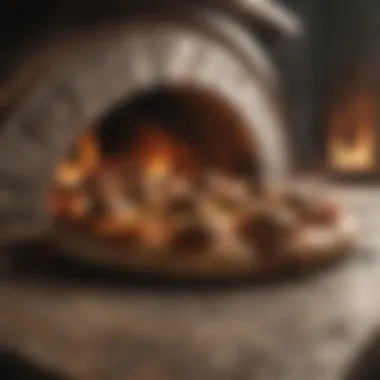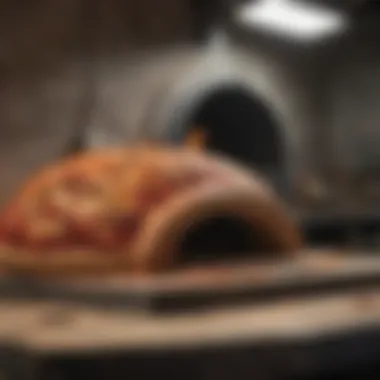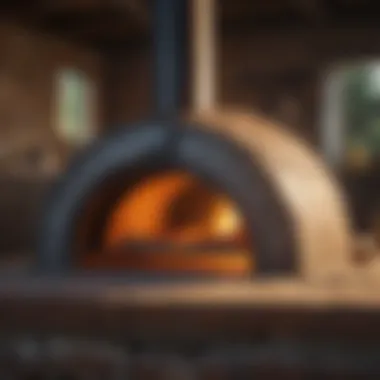Materials:
To start your endeavor of building a pizza oven from scratch, you need to ensure you have all the necessary materials ready. The list of materials includes 28 refractory bricks measuring 9x4.5x2.5 inches each, 3 fire bricks of 9x4.5x2.5 inches for the base, a bag of refractory mortar, a bag of sand, and 20 fire-resistant tiles for the roof. Additionally, you will require a steel plate with a thickness of 4mm, measuring 1x1 meter, a chimney pipe of 6-inch diameter, vermiculite insulation, and a steel door.
DIY Steps:
1. Foundation Preparation:
Start by laying a solid foundation using concrete blocks to support the weight of the oven. Ensure the base is level and stable for construction to prevent any structural issues later on.
2. Building the Base:
Using the fire bricks, construct a sturdy and heat-resistant base for the oven. Place the bricks in a herringbone pattern to provide strength and durability to the structure.
3. Constructing the Walls:
Layer the refractory bricks using refractory mortar to build the walls of the oven. Leave space for the entrance and the chimney while ensuring the bricks are securely bonded together.
Technical Aspects:
In terms of tools, you will need a spirit level to ensure the evenness of the foundation and walls, a trowel for applying mortar, a saw for cutting bricks to size if necessary, and protective gear such as gloves and goggles. The timing of the project will depend on your skill level but allocating a weekend for the construction process is advisable. Critical techniques include proper mortar application to create a secure bond between the bricks and ensuring the chimney is installed correctly.
DIY Project Process:


1. Installation Method:
Once the walls are complete, insert the steel plate as the base of the oven, followed by layering vermiculite insulation to retain heat efficiently. Place the fire-resistant tiles on top to create a durable roof structure.
2. Troubleshooting Tips:
If you encounter any cracks in the mortar, patch them up immediately to prevent heat leakage. Ensure the chimney is free from blockages for proper ventilation. Regularly inspect the oven for any wear and tear to maintain its longevity and performance.
Introduction


Welcome to the comprehensive guide on constructing your very own pizza oven from scratch. Within this article, we delve into the intricacies of this delightful endeavor, providing you with a step-by-step walkthrough that ensures a successful outcome.
Understanding the Benefits of Building a Pizza Oven
Building a pizza oven offers a myriad of advantages that elevate your culinary experience. One of the most enticing benefits is the enhanced taste and flavor it imparts to your pizzas. By utilizing a pizza oven, you can achieve a distinctive smoky char and a perfectly crisp crust that elevates the overall dining experience. This unique cooking method ensures that each bite is a burst of flavor, significantly enhancing your homemade pizza game to professional levels.
Moving on to the cost-effectiveness aspect, building your pizza oven can lead to substantial savings in the long run. While the initial investment might seem significant, the ability to control energy usage and maximize efficiency results in reduced operational costs over time. This cost-effectiveness makes owning a pizza oven not just a gastronomic indulgence but also a financially savvy choice for avid home cooks.
Furthermore, the customization options presented by building a pizza oven are truly incomparable. You have the creative freedom to personalize your oven according to your preferences and needs. Whether it's adding decorative elements or tweaking the design to align with your outdoor space, the customization options are boundless. This level of personalization ensures that your pizza oven reflects your unique style and culinary identity, setting it apart from conventional alternatives.
Materials and Tools Needed


Before embarking on your pizza oven construction journey, it's essential to gather the necessary materials and tools. Firebricks play a crucial role in constructing the oven chamber due to their excellent heat retention properties and durability. Concrete mix is another vital component for building the oven base and ensuring structural stability. Additionally, a reliable thermometer is essential for monitoring the internal temperature of the oven accurately.
When it comes to insulating materials, choosing the right option is paramount to the oven's performance. High-quality insulation ensures that the oven retains heat effectively, resulting in consistent and optimal cooking conditions. By selecting the appropriate materials and tools, you lay a solid foundation for a successful pizza oven construction project.
Choosing the Right Location
Selecting the ideal location for your pizza oven involves considering outdoor factors and ventilation requirements. Outdoor considerations such as sun exposure and proximity to flammable materials can impact the oven's performance. Adequate ventilation is essential to ensure proper airflow and maintain a safe cooking environment. By meticulously evaluating these factors, you can create a functional and efficient space for your pizza oven, allowing you to fully enjoy the art of pizza making in your backyard.
Construction Process
The construction process of building your own pizza oven is a crucial phase in this DIY project. It sets the foundation for the oven's functionality and durability. This section will guide you through the key steps involved in creating your pizza oven from scratch with detailed precision and accuracy.
Preparing the Base
Marking the Foundation Area
Marking the foundation area is the initial step in establishing a stable base for your pizza oven. This process involves outlining the shape and size of the base to ensure a proper foundation. By marking the area accurately, you set the groundwork for a structurally sound oven base, facilitating the subsequent construction phases seamlessly.
Leveling the Ground
Achieving a leveled ground is essential to prevent any instability in the pizza oven structure. By ensuring the ground is flat and even, you create a solid platform for building the oven. Leveling the ground meticulously guarantees the overall stability and functionality of the oven, contributing to its longevity.
Pouring Concrete
Pouring concrete over the leveled ground forms the solid foundation for your pizza oven. Concrete provides strength and support to the base, creating a robust structure. The process of pouring concrete requires precision to ensure proper alignment and thickness, enhancing the integrity of the oven's foundation.
Building the Oven Structure
Layering Firebricks
Layering firebricks forms the walls of the pizza oven, offering heat retention and durability. Firebricks are chosen for their ability to withstand high temperatures, essential for optimal pizza baking. By layering the firebricks carefully, you create the heat-resistant inner structure of the oven, facilitating efficient heat distribution.
Creating the Dome Shape
Creating the dome shape of the oven focuses on forming the distinctive rounded top that characterizes traditional pizza ovens. The dome shape plays a critical role in heat circulation and retention, key for achieving that perfect, crispy crust. This step demands attention to detail to craft the ideal dome for your oven.
Installing the Entrance
Installing the entrance to the pizza oven involves crafting the opening that allows for easy access to the cooking area. The entrance design influences heat retention and airflow within the oven. By installing the entrance strategically, you ensure efficient heat circulation and convenient operation of the oven.
Adding Insulation and Finishing Touches
Applying Insulating Materials
Applying insulating materials around the oven helps retain heat and improve energy efficiency. Insulation prevents heat loss, maintaining the oven's temperature for extended periods. Choosing the right insulating materials and applying them correctly enhances the overall performance and thermal insulation of the oven.
Decorative Elements
Incorporating decorative elements adds a personalized touch to your pizza oven, enhancing its visual appeal. Decorative finishes can include mosaic tiles, stucco, or other creative elements that reflect your style. These additions not only beautify the oven but also protect it from external elements, contributing to its longevity.
Firing Up Your Pizza Oven
Firing up your pizza oven is a crucial step in the construction process. This phase is where you prepare the oven for its first use, ensuring that it functions optimally and efficiently. Properly firing up the oven is essential to curing the materials and preparing them for the high temperatures required for baking perfect pizzas. During this stage, it's important to follow specific guidelines to avoid damage and ensure your oven's longevity.
Curing Process
Gradual Heating
Gradual heating plays a vital role in the curing process of your pizza oven. By slowly warming up the oven, you allow the materials to expand and contract without cracking. This gradual approach helps in eliminating any residual moisture and organic compounds in the materials, preventing potential damage when exposed to direct heat. It is a favored method for its ability to strengthen the oven structure and enhance its durability over time.
Moisture Removal
Moisture removal is a critical aspect of the curing process as it eliminates any water or dampness trapped within the oven materials. By drying out the materials thoroughly before regular use, you prevent steam from forming rapidly during heating, which could lead to cracks or instability in the oven structure. Proper moisture removal not only ensures a strong and stable oven but also contributes to the overall quality and taste of the pizzas baked.
Testing the Temperature
Using a Thermometer
Utilizing a thermometer is key to accurately gauging the internal temperature of your pizza oven. This allows you to ensure that the oven reaches the optimal heat levels required for baking different styles of pizzas. By monitoring the temperature throughout the process, you can make necessary adjustments to maintain a consistent baking environment and achieve perfect results every time. The thermometer provides precision and control, enhancing your baking experience and culinary outcomes.
Optimal Heat Levels
Optimal heat levels are crucial for producing delicious pizzas with the desired texture and flavor. By understanding and controlling the heat distribution within your oven, you can tailor your cooking techniques to suit different recipes and preferences. Maintaining the ideal temperature ensures proper crust development, cheese melting, and ingredient cooking, resulting in consistently satisfying pizzas. Achieving and maintaining optimal heat levels is fundamental to the success of your homemade pizzas.
First Pizza Experience
Choosing Ingredients
The choice of ingredients significantly influences the taste and quality of your homemade pizzas. Selecting fresh, high-quality ingredients like ripe tomatoes, premium cheeses, and organic vegetables enhances the flavors and aromas of your pizzas. Experimenting with different combinations and variations allows you to personalize each pizza to your liking, creating a unique dining experience for yourself and your guests. Choosing top-notch ingredients elevates the overall enjoyment and satisfaction of your first pizza baked in your homemade oven.
Baking Techniques
Mastering proper baking techniques is key to achieving that perfect pizza from your homemade oven. Techniques such as stretching the dough evenly, topping the pizza evenly, and rotating it during baking contribute to a well-balanced and delicious final product. Understanding how different techniques affect the cooking process and overall outcome empowers you to create pizzas that rival those from professional pizzerias. By honing your baking skills, you can replicate your favorite pizza styles and experiment with new culinary creations with confidence.
Maintenance and Troubleshooting
Maintenance and troubleshooting plays a crucial role in ensuring the longevity and optimal performance of your homemade pizza oven. By adhering to regular maintenance practices, you can prevent potential issues and enhance the efficiency of your oven. One of the key elements of maintenance is cleaning and care, which involves two main aspects: removing ash and sealing cracks.
Cleaning and Care
Proper cleaning and care are essential to keep your pizza oven functioning effectively. Removing ash is a vital step in the cleaning process. It involves clearing out the ash residues left after each use. By removing ash promptly, you prevent it from blocking airflow and impacting the combustion process in the oven. This simple task not only maintains the cleanliness of your oven but also contributes to the even distribution of heat, ensuring that your pizzas are cooked to perfection.
On the other hand, sealing cracks is another crucial aspect of maintenance. Over time, the intense heat generated in the pizza oven can lead to the development of cracks in the structure. Sealing these cracks helps prevent heat loss and ensures that the oven retains its efficiency. By addressing any small cracks promptly with suitable heat-resistant materials, you can avoid larger problems down the line.
Common Issues and Solutions
Uneven Heating
Uneven heating can be a common issue in pizza ovens, affecting the consistency of your pizza results. This problem often arises due to improper insulation or airflow within the oven. To address uneven heating, you can try repositioning the firebricks or adjusting the ventilation openings to regulate the heat distribution. Additionally, ensuring proper insulation and sealing any gaps can help maintain consistent temperatures throughout the cooking process.
Smoke Leakage
Smoke leakage poses another challenge for pizza oven owners, affecting both cooking efficiency and safety. The presence of smoke outside the designated chimney can indicate issues with the ventilation system or cracks in the oven structure. To tackle smoke leakage, inspection of the chimney, flue, and seals is essential. Sealing any gaps or cracks in these areas and improving the airflow design can help mitigate smoke leakage and create a safer cooking environment.
Conclusion
Building your own pizza oven can be a fulfilling and rewarding experience that goes beyond just creating a cooking appliance. It represents a journey of craftsmanship, patience, and dedication. Throughout this article, we have delved into every aspect of constructing a pizza oven, from understanding the benefits of building one to firing it up for the first time. The conclusion marks the beginning of a new chapter, one filled with the joy of homemade pizzas and the satisfaction of a project successfully completed. Connecting with the essence of traditional cooking methods and relishing the flavors of a wood-fired pizza can be a delightful experience that brings people together.
Enjoying Homemade Pizza
Family Gatherings
Embracing family gatherings around a homemade pizza oven can foster a sense of togetherness and warm camaraderie. The shared experience of preparing and savoring delicious pizzas can create lasting memories and strengthen familial bonds. The aroma of freshly baked pizzas wafting through the air can set the stage for meaningful conversations and joyful laughter. Family gatherings provide an opportunity to disconnect from the hectic pace of modern life and reconnect with loved ones in a cozy and intimate setting. The versatility of a pizza oven allows for everyone to participate in the cooking process, making it a truly collaborative and enjoyable activity. The ability to customize toppings and experiment with different recipes adds a fun and creative element to the gatherings, making them a cherished tradition for families.
Culinary Creativity
Exploring culinary creativity with a homemade pizza oven opens up a world of possibilities for experimenting with flavors and ingredients. The flexibility of a pizza oven enables individuals to create unique and personalized culinary creations that cater to their specific tastes. From classic Margherita pizzas to innovative combinations of cheeses, meats, and vegetables, the only limit is one's imagination. The process of crafting and refining pizza recipes can be a form of artistic expression, allowing individuals to showcase their skills and culinary flair. Culinary creativity not only enhances the dining experience but also encourages individuals to step out of their comfort zones and discover new flavor profiles. Whether hosting a gathering or simply indulging in a solo cooking session, culinary creativity with a homemade pizza oven promises a delicious and satisfying culinary journey.





